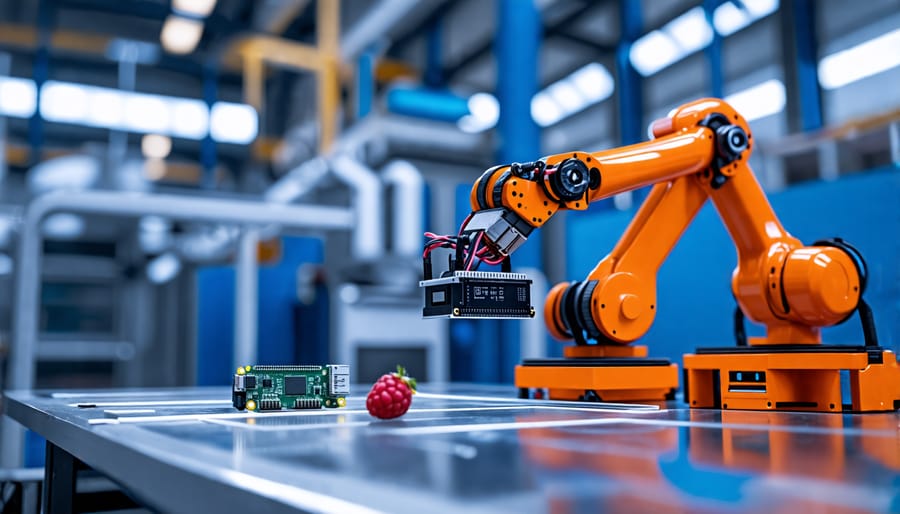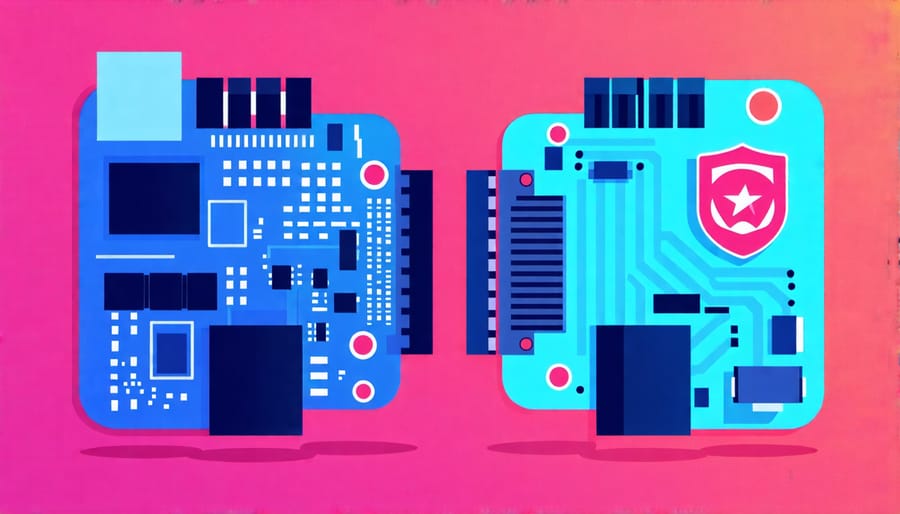Harness the power of Raspberry Pi in industrial automation by integrating it into your existing machinery to enhance control and monitoring capabilities. Utilize GPIO pins to interface with sensors and actuators, enabling real-time data collection and automation of repetitive tasks. Secure your setup by implementing network encryption protocols and ensuring regular software updates to safeguard against cyber threats. Experiment with Python scripting to develop customized automation routines, leveraging libraries like RPi.GPIO to interact with hardware components efficiently. Embark on hands-on projects such as automating assembly line operations or optimizing energy consumption in HVAC systems, all while maintaining cost-effectiveness and flexibility.
Advantages of Using Raspberry Pi in Industry
Cost Savings
Raspberry Pi’s affordability significantly reduces operational costs in industrial automation by offering a low-cost alternative to traditional PLCs and control systems. Starting at just around $35, Raspberry Pi provides sufficient processing power and flexibility for a wide range of automation tasks. Businesses can cut expenses on hardware and maintenance without sacrificing performance. Moreover, the open-source nature of the Raspberry Pi ecosystem fosters a wealth of free resources and community support, which reduces development costs and time. Its energy-efficient design also lowers power consumption, further minimizing operating costs. Overall, Raspberry Pi enables cost-effective automation, making it accessible for both small enterprises and large-scale operations.

Versatility and Flexibility
Raspberry Pi’s versatility makes it an appealing choice for industrial automation thanks to its adaptability across various applications. Whether you’re a tech enthusiast or a hobbyist, the Raspberry Pi can be harnessed to control machinery, manage sensor data, or even automate processes in a factory setting. Its compact design and extensive library of GPIO (General Purpose Input/Output) pins allow for seamless integration with other industrial-grade hardware. Moreover, the flexibility of programming languages and the wide support for different software frameworks mean you can easily tailor a Raspberry Pi project to meet specific operational requirements, making automation both accessible and cost-effective.
Community Support
Raspberry Pi’s vibrant community offers invaluable support for those venturing into industrial automation. Tech enthusiasts and hobbyists have cultivated a global network where troubleshooting challenges are met with collaborative solutions. Online forums, subreddit discussions, and dedicated Raspberry Pi platforms act as hubs for sharing code snippets, detailed schematics, and hands-on project tutorials. This collective wisdom accelerates problem-solving and fosters innovation, empowering users to transform ideas into reality swiftly. Beginners and seasoned developers alike can find tailored advice and inspiration, making Raspberry Pi not just a tool for automation but a gateway to endless possibilities, guided by a supportive community eager to help at every step.
Key Applications in Industrial Automation
Robotic Controls
Raspberry Pi plays a pivotal role in controlling robotic operations, making it an ideal choice for tech enthusiasts and hobbyists eager to explore automation projects. Its versatility and affordability allow users to creatively integrate Raspberry Pi into various robotic systems, from simple robotic arms to complex autonomous vehicles. The Raspberry Pi’s GPIO pins facilitate seamless interaction with sensors and actuators, essential components in robotics. This microcomputer’s compatibility with popular programming languages like Python provides an accessible entry point for beginners looking to delve into coding and automation.
For an engaging hands-on experience, consider starting with Raspberry Pi robotics projects that showcase how this microcomputer can be used to build and program robots efficiently. By leveraging open-source platforms and modular hardware, even those new to industrial automation can experiment with robotic controls, fostering innovation and practical learning. Whether you’re aiming to prototype new ideas or enhance your existing systems, Raspberry Pi serves as a robust tool to bring your robotic visions to life.

Monitoring and Data Collection
Leveraging the Raspberry Pi for process monitoring and data analytics in industrial automation opens up a world of possibilities for tech enthusiasts and educators. This compact yet powerful device can be equipped with sensors to track temperatures, motions, or even vibration levels, providing real-time data on various processes. By interfacing with industry-standard protocols like Modbus or OPC-UA, Raspberry Pi can seamlessly integrate into existing systems, serving as a cost-effective alternative for data-heavy environments.
Once data is captured, the Raspberry Pi’s computational capabilities allow for on-the-fly data processing and analysis. Using Python libraries such as Pandas and NumPy, users can perform complex data analyses to identify patterns or anomalies, ultimately improving decision-making processes. Furthermore, the Raspberry Pi can connect to cloud platforms like Azure or AWS, facilitating remote monitoring and data storage while ensuring scalability.
By deploying Raspberry Pi in industrial settings, users not only gain insights into operational efficiencies but also open the door for further innovations through continuous data feedback and problem-solving opportunities.
IoT Integration
Integrating Raspberry Pi with IoT for industrial automation offers a cost-effective and highly flexible solution for enhancing operational efficiency. By connecting Raspberry Pi to IoT devices and platforms, industries can enable real-time monitoring and control over their processes, from remote location management to predictive maintenance. With its compact size and powerful processing capabilities, Raspberry Pi facilitates data collection and analytics, transforming it into actionable insights that improve productivity. Moreover, the ease of integrating various sensors and cloud services allows even beginners to develop sophisticated automation systems. This democratization of technology empowers both pioneers and newcomers to innovate in industrial settings.
Security Considerations for Raspberry Pi in Industrial Automation
Potential Security Risks
Using Raspberry Pi for industrial automation presents exciting possibilities, but it’s crucial to be aware of potential security risks. By integrating Raspberry Pi devices into industrial settings, you’re exposing them to vulnerabilities typical of IoT (Internet of Things) environments. For instance, unsecured networks can lead to unauthorized access, which might result in data breaches or operational disruptions. It’s also common for Raspberry Pi devices to run outdated software, making them susceptible to known exploits. Physical security is another consideration; since Raspberry Pi units are compact and portable, they can easily be tampered with or stolen if not properly secured.
To mitigate these risks, adopting IoT security essentials is vital. This includes ensuring your Raspberry Pi operates on the latest firmware updates and employs robust authentication methods. Additionally, segmenting networks can significantly reduce the impact of potential breaches by isolating critical systems. By understanding these vulnerabilities and taking proactive steps, you can safely harness the power of Raspberry Pi in industrial automation projects.

Best Practices for Securing Raspberry Pi Systems
Securing Raspberry Pi systems is essential, especially in industrial automation where they can control critical operations. Begin by implementing bulletproof security steps like changing the default username and password. This is one of the simplest, yet most effective measures to prevent unauthorized access. Also, ensure your Pi’s operating system and all installed packages are regularly updated. Updates often contain important security patches that protect your device against vulnerabilities.
Consider setting up a firewall to filter incoming and outgoing traffic, which can block malicious attempts to exploit your network. Additionally, disable unused services to reduce the attack surface of your Raspberry Pi. Enabling SSH access with key-based authentication, instead of just passwords, can also significantly bolster security. For those connected to a network, network segmentation can limit potential exposure by isolating your Pi from less secure devices. By actively applying these strategies, you can maintain robust security for your Raspberry Pi projects in industrial settings.
Hands-On Project: Building an Automated Conveyor Belt System
Required Components
To successfully implement a Raspberry Pi in an industrial automation project, you’ll need several essential components. Start with a reliable Raspberry Pi model, such as the Raspberry Pi 4, known for its processing power and versatile connectivity options. Add a microSD card, at least 16GB, loaded with an appropriate operating system like Raspberry Pi OS. For connecting to machinery, include GPIO extension boards, relays, and sensors tailored to your specific needs. You’ll also need a robust power supply, typically 5V/3A, for consistent operation. Consider adding an Ethernet cable or Wi-Fi adapter for networking. Finally, include a durable case to protect your setup in industrial environments.
Step-by-Step Instructions
To begin assembling your Raspberry Pi-powered automated conveyor belt system, gather the essential components: a Raspberry Pi board, a motor driver, an electric motor, a conveyor belt, sensors (e.g., IR, ultrasonic), a power supply, and necessary cables. Start by securely mounting the Raspberry Pi onto a base near the conveyor belt. Attach the motor to the conveyor framework and connect it to the motor driver, ensuring the proper alignment for movement.
Next, wire the motor driver to the Raspberry Pi’s GPIO pins. Refer to the motor driver’s datasheet for pin layout, and ensure connections for power, ground, and control signals are correct. Now, integrate the sensors. For instance, position an infrared sensor at the conveyor’s entry point to detect objects, and wire it to the Raspberry Pi.
With the hardware set up, turn your attention to programming. Install Raspbian OS on your Raspberry Pi if not already done, and then install any necessary Python libraries, such as RPi.GPIO for GPIO control. Write a Python script to manage the motor based on sensor input. For example, your script could start the motor when an object is detected and stop it after the object passes the belt. Test your setup by running the script and making adjustments to the sensor sensitivity or motor speed as needed.
Experiment with adding features, such as controlling the system remotely via a web server. This project not only illustrates Raspberry Pi’s industrial automation capabilities but also serves as a practical introduction to integrating hardware with software for automation systems.
Conclusion
Raspberry Pi’s potential in industrial automation is immense, offering a cost-effective and flexible solution for various applications. Its ability to handle tasks ranging from simple monitoring systems to complex control operations makes it a smart tech investment for both beginners and seasoned professionals. As industries move towards more integrated and efficient processes, the Raspberry Pi stands out as a key player. We encourage you to dive deeper into its versatile capabilities, experiment with projects, and explore how it can revolutionize the automation landscape in a practical and impactful way.


